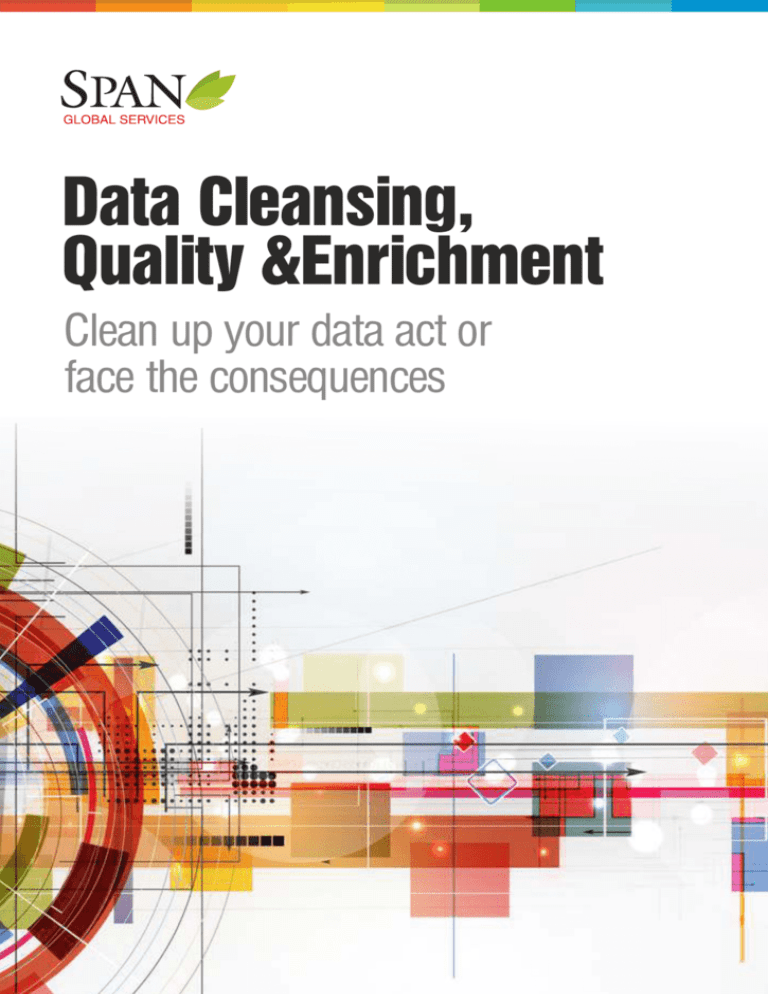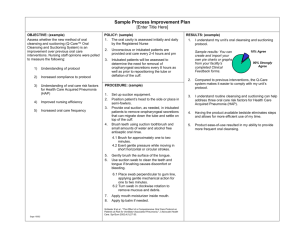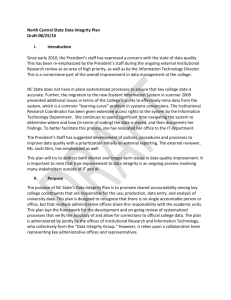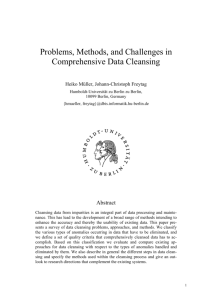
Data Cleansing,
Quality &Enrichment
Clean up your data act or
face the consequences
Introduction
Poor data quality is the primary reason for 40% of all
business initiatives failing to achieve their targeted benefits
(according to Gartner). It has been found that data quality
problems cost 10% of the total revenue. The staff of an
organization spends 25% of its time in handling customer
complaints caused by erratic data, fixing incorrect data,
finding missing data, and clarifying data that doesn’t make
any sense.
BAD DATA – BAD IMPACT!
Respondents in a survey said that poor data quality causes
87%
27%
With the evolution of information age, there is enormous
amount of data which has been made readily available
through the virtual media and sophisticated
communications network. There is a widespread
conceptual application of internet in supply chains, data
mining, knowledge management and many other related
concepts. There has been a considerable increase in
independent distributed database servers that directly
provide online info-retrieval services to end users This has
facilitated information manipulation of multi-source data to a
great extent. The resulting integration of data from multiple
independent sources, results in certain incompatibilities.
Most of the users neglect the importance of data in
computers but data acts as the real fuel in the information
technology engine. Incorrect and futile data should be
removed as it results in faulty analysis.
Inaccurate data leads users to make faulty decisions. The
impact of data errors is felt by everyone at one time or
another, no matter to which function of work the user
belongs – management, internet applications, financial
applications, marketing or information services. Mostly,
poor data quality results in loss of time, money and the effort
behind critical business decisions.
71%
49%
71% - Financial reporting problems
49% - Operations problems from bad data
87% - Excess costs for business operations
27% - Strategic planning problems
Source http://www.mytechanalyst.net/2013/10/07/
baddata-is-a-social-disease-part-1/
www.spanglobalservices.com
Call Us: 877-837-4884
info@spanglobalservices.com
Why are Data Cleansing, Quality and
Enrichment important?
What is Data Cleansing?
Data cleansing, also called data scrubbing, deals with
detecting and removing errors and inconsistencies from
data in order to improve the quality of data. Data quality
problems are present in single data collections, such as files
and databases, e.g., due to misspellings during data entry,
missing information or other invalid data. When multiple data
sources need to be integrated, e.g., in data warehouses,
federated database systems or global web based
information systems, the need for data cleansing increases
substantially. This is because the sources often contain
redundant data in different representations. In order to
provide access to accurate and consistent data,
consolidation of different data representations and
elimination of duplicate information become necessary.
Report
Enrich
NEW PERSPECTIVE
Data actively collected with user
awareness
Most data from machine to machine
transactions & passive collection difficult to notify individuals
Definition of personal data is
predetermined and binary
Definition of personal data is
contextual and dependent on
social norms.
Data collected for specified use
Economic value and innovation
come from combining data sets
and subsequent uses.
User is the data subject
User can be the data subject, the
data controller, and/or data
processor
Individual provides legal consent
but is not truly engaged.
Individuals engage and understand
how data is used and how value is
created
Policy framework focuses on
minimizing risks to the individual.
Policy focuses on balancing
protection with innovation and
economic growth.
Transform
Match
A data cleansing approach should satisfy several
requirements:
1. Detect and remove all major errors and inconsistencies
both in individual data sources and when integrating multiple
sources. The approach should be supported by tools to limit
manual inspection and programming effort and be
extensible to easily cover additional sources.
2. Data cleansing should not be performed in isolation but
should be based on comprehensive metadata. Required
mapping functions for data cleansing in accordance with the
Meta data should be specified and be reusable for not just
other data sources but also for query processing. Especially
for data warehouses, a workflow infrastructure should be
supported to execute all data transformation steps for
multiple sources and large data sets in an efficient manner.
www.spanglobalservices.com
TRADITIONAL APPROACH
Profile
Cleanse
Merge
According to a Market report, the greatest barriers to B2B
lead generation are predominantly the result of bad data
quality. With such huge repercussions that the business
needs to face due to poor data; Cleansing, Quality and
Enrichment gain importance. Most functions in business
are data centric from accounting to highly creative
department marketing. With such emphasis on good data
leading to great business performance it is critical to ensure
the data complies with the industry standards.
With so many sources for the collation of data, the
probability of making errors like duplication and missing of
fields is high. Also with the emergence of cloud-based data
collection techniques the reasons and the approaches for
data collection have also changed. Now, data collection is
not done just with the intention of implementing a particular
process but also helps in making strategic business
decisions. These decisions determine whether or not a
process is worth the effort. From pre-planning to the
execution and further to the result; data drives the whole
cycle.
Call Us: 877-837-4884
info@spanglobalservices.com
Phases in Data Cleansing
Data Standardization:
In general, data cleansing involves several phases
Data
Analysis
Quality
Check
Data
Cleansing
Data
Normalization
Data standardization is the first step to ensure that your data
is ready to be shared across the enterprise. This establishes
trustworthiness for the data to be used by other applications
in the organization. Ideally, such standardization should be
performed during data entry. If, for some reason this is not
possible, a comprehensive back-end process is necessary
to eliminate any inconsistencies in the data. Data
standardization is usually done under name heads like
Name, Address, Product, Business, Financial etc.
Data
De-duplication
Data
Standardization
Data
Standardization
Data normalization:
Data analysis:
In order to detect which kinds of errors and inconsistencies
are to be removed, a detailed data analysis is required. In
addition to a manual inspection of the data or data samples,
analysis programs should be used to gain metadata about
the data properties and detect data quality problems.
It is the process of organizing the fields and tables of any
relational database to minimize redundancy. Normalization
usually involves splitting of larger tables into smaller (and
less redundant) tables and mapping relationships between
them. The objective is to isolate data so that additions,
deletions, and modifications of a field can be made in just
one table and then propagated through the rest of the
database using the mappings created.
Quality Check:
Data de-duplication:
It is a specialized data compression technique for
eliminating duplicate copies of repeating data. This
technique is used to improve storage utilization and can also
be applied to network data transfers to reduce the number of
bytes that must be sent. In the de-duplication process,
unique chunks of data, or byte patterns, are identified and
stored during a process of analysis. As the analysis
continues, other chunks are compared to the stored copy
and whenever a match occurs, the redundant chunk is
replaced with a small reference that points to the stored
chunk. Given that the same byte pattern may occur dozens,
hundreds, or even thousands of times (the match frequency
is dependent on the chunk size), the amount of data that
must be stored or transferred.
This should be performed at every level of Data cleansing.
But for obvious reasons, like the source and timing of the
data receipt might vary largely, making it difficult to check
and assure the quality at the very beginning. Hence an
assigned stage of quality check becomes imperative. A
typical outline of the timeline at which a quality check
process is assigned is illustrated below –
Data
generation
• Different sources
• Different times of data collection
Different
file formats
• Excel files
• Text files
Application
program
functionalities
www.spanglobalservices.com
Call Us: 877-837-4884
• Importing data from different files
• Filling data gaps
• Quality Check
• Derived parameters
info@spanglobalservices.com
Benefits of Data Cleansing
The 5 key issues with data quality
There are plenty of financial benefits to cleansing your
databases, not only will such activities stop you wasting
money on storing old or obsolete data, but the improved
accuracy can result in greater return on investment for your
marketing activities.
ISSUE #1: Inconsistent Data
Assists in your target profiling, meaning that your
marketing campaigns will be more focused, relevant and
subsequently more likely to be successful.
Understandably, using obsolete data for your targeting
activities will only lead to misdirected campaigns
Storing old information can actually harm your brand
image and customer perception. For instance, if you are
consistently sending marketing literature to old
addresses, customers that may have died or opted out of
receiving promotional material, your efforts are actually
helping to create a wider negative image, rather than
return on investment
In compliance to the Data Protection Act with regards
to the storage of personal information, cleansing
activities are necessary to eliminate any chances of
violation of the act and subsequent penalties
Finally, improving the quality of your data results in
improved customer insight and adds considerable
value to your marketing efforts by improving ROI
These are just some of the reasons to undertake data
cleansing, however, as a business, it should be
remembered that the process is ongoing. Databases require
practically constant management and cleansing to ensure
they contain, up to date, accurate and valuable information.
In short, improve the quality of the data.
Report
Profile
Enrich
Transform
Data storage at more than one place results in data
inconsistency. Thus on some occasions
changes may not be made at all places which results in lack
of data integrity.
The average duplication ratio in vendor names is more
frequent than that of software product names which is 10:1
than 20:1 in the latter. This is often observed because the
consistency across names is difficult to assign. Most
software product names are trademark or registered
entities.
ISSUE #2: Duplicate or Conflicting Data
Most of the relational databases are a combination of data
from multiple sources; they often contain duplicate data. If
the database is to be the authoritative system of record
supporting IT decisions and processes, it needs to resolve
those conflicts and filter out duplicates. The problem and the
impact can be huge. Different inventory and asset
management tools may insert duplicate data, for many
reasons. When the problem scales up, searching and fixing
the duplicates/conflicts can be a huge task.
An unbiased research of the industry conducted by BDNA
shows that 40 percent of data collected across different
sources is repeated.
ISSUE #3: Irrelevant Data
Another issue is data relevance. Removing the irrelevant
data can reduce the data footprint significantly. For
example, when looking at data for an audit, you do not need
to look at files that are individual components of a larger
bundle. Ignoring those files helps to eliminate the frequency,
so that you can focus on the remaining percent of data that is
relevant.
A research done by BDNA shows that 95% of data gathered
from various discovery sources is irrelevant.
Cleanse
Merge
Match
www.spanglobalservices.com
Call Us: 877-837-4884
info@spanglobalservices.com
ISSUE #4: Incomplete Data
After you have addressed issues like inconsistency and
duplication, the database needs to be looked in for missing
data that you need to make decisions. The source of the data
has to be authentic for the data to be of the highest quality.
Along with the source, the collection systems also largely
determine the quality and completeness of the database. IT
systems lack critical information you need to know about all
of your assets, such as end-of-life or end-of-support date,
licensing/packaging options, current version, etc. These
external data points – market data – are essential for many
day-to-day processes.
There are various categories of data fields that might be
incomplete. The probability of missing data should be
assessed prior to the database design. For example, a
respondent survey about income of an individual has a very
high chance of being left incomplete.
Intrinsic – The data should be accurate. Accuracy covers
most of the aspects of duplication, relevance and
authenticity. The sources of the data collated should be
reliable and reputable. A clear objective needs to be
specified for the data to be acceptable as high quality.
Contextual – The right thing at the right time is the key to the
context of a database. Timely and relevant value added to
the database ensures the completeness of the data. Also, a
large database does not mean a database which has fields
that are of no monetary or strategic relevance.
Representational – The database needs to be easy to
understand and user friendly. A complicated data only uses
a lot of more time for the user to access and make good use
of the same.
Accessibility – The security and availability of the data over
networks and at the required time of access is essential.
Data available at the right time enables right decisions.
ISSUE #5: Incomplete Data
It’s mandatory that some of the data in your entire database
is now outdated. There is a continuous inflow of some
information with the IT systems in place currently. Most data
collected and then collated are more a mundane process
than a requirement. With such collection systems, we need
to determine a threshold after which the data which is not of
any relevant use should be destroyed. This would eliminate
the problem of outdated data at large.
Dimension
Intrinsic
Characteristics
Believable, Accurate
Objective, Reputable
Contextual
Value-Added, Relevant
Timely, Complete
Appropriate amount
Representational
Interpretable, Easy to understand
Consistent , Concise
Accessibility
Available, Secure
25 percent of the Fortune 500 use software that is past its
support date.
Features that describe data quality
We had a look at the issues due to which the quality of the
databases gets hampered. It is important for us to know the
essential features that help us in the assessment of the
quality of any large data. The four cornerstones of data of the
highest quality are
www.spanglobalservices.com
Call Us: 877-837-4884
info@spanglobalservices.com
Data Enrichment –
How is it different from data quality?
The fourth step in an effective data quality methodology
involves creating as complete a picture as possible to
support strategic decision-making. Data enrichment can
range from something as simple as adding a missing
postcode, to augmenting records with demographic or
geographic data based on a name or address match. It's a
simple process, with the value gained far outweighing the
effort required.
Enhance and Enrich examples –
List Management
Email Lists
List Building
Data Management
Data Cleansing
Data Profiling
Data Verification
Data Appending
Geographic: such as postcode, county name, longitude and
latitude, and political district
Email Appending
Phone Appending
Behavioral: including purchases, credit risk and preferred
communication channels
Contact Appending
Social Media Profile Appending
Demographic: such as income, marital status, education,
age and number of childre
Conclusion
Psychographic: ranging from hobbies and interests to
political affiliation
The maintenance of data isn’t something that occurs only
Census: household and community data
before you use it for marketing purposes. It encapsulates
the processes before use of the data and after use of the
While most data quality tools focus on name and address
data, the data enrichment processes should support any
number of non-name and non-address data types, including
dates, telephone numbers, account numbers and e-mail
information, to name just a few. The process should also
enable full customization of the data quality rules engine, so
you can modify existing rules, tweak data types and create
your own data types. For example, If you want to parse,
standardize and match product names, you simply create a
"product name" data type that is specific to the type of data
you have.
data. Processes need to be in place where all changes and
updates are fed back into the database to ensure accuracy
and consistency. Networks are changing all the time, with
new devices and software. And the vendors are
constantly changing, with new software versions, patch
updates, product names, mergers and acquisitions, and
support changes. A large organization may have hundreds
of updates each week. The industry keeps changing,
issuing new releases, while you’re gathering the data.
Organizations often spend a lot of time and money in the
initial setup of the collection of the data and setting up the
About Us
system to collate. But then they find that the updates are
quiet frequent. Any failure in maintaining and updating
Span Global Services offers following Data Solutions to
keep your data up-to-date to get optimum results and
improve ROI. Translate data into actionable insights with our
solutions. We provide the following services:
would lead to outdated data systems and fields. Due to the
various issues that impact data quality, only a very small
percentage of the overall data is really clean. Most of the
remaining data should be discarded. The clean data should
then be enriched with market information to give you the
data that really matters.
www.spanglobalservices.com
Call Us: 877-837-4884
info@spanglobalservices.com
References
1. Data mining and knowledge discovery handbook,
Chapter 2, Data cleansing – A prelude to knowledge
discovery; Jonathan.I. Maletic, Kent state university.
15. Data Quality Strategy: A Step-by-Step Approach http://www.meritalk.com/uploads_legacy/whitepapers/WP
3131_A_DQ_Step_Approach.pdf
2. Data Mining and Knowledge Discovery, 2, 9–37 (1998) ©
1998 Kluwer Academic Publishers, Boston
16.
Essential Data Quality Management http://dma.org.uk/sites/default/files/tookit_files/wp_essenti
al_data_quality_management.pdf
3. Data Cleaning: Problems and Current Approaches;
http://dbs.uni-leipzig.de
4. Think you have clean data in your CMDB? Think again!
www.bdna.com
GLOBAL SERVICES
5. What does Data Cleansing & Enhancement mean and
how can I justify it?
© Span Global Services 2014, All rights reserved
www.celsiusinternational.com
6. Data Quality - A problem and An Approach – Whitepaper,
Authors - Javed Beg and Shadab Hussain
7. How Data Cleansing always saves money for Mailing
Campaigns - http://www.data-8.co.uk
8. Enterprise Data Quality – Viewpoint by Sivaprakasam
S.R.
9. Data Quality Management –Maximize Your CRM
Investment Return - www.activeprime.com
10. Trends In Data Quality And Business Process Alignment
– A forrester research report, November 2011
11. The Cost of Dirty Data – An educational report
https://www.vha.com/Solutions/Analytics/Pages/DataLYNX
.aspx
12. The Cost of Poor Data Quality - How to make better
business decisions and positively affect your bottom line ©
The D&B Companies of Canada Ltd
13. A case for Data Cleansing – Whitepaper www.imaltd.com
14. Data Quality: A Critical Component of Business
Assurance -
Span Global Services
848 N. Rainbow Blvd.
Suite#5439 Las Vegas, NV 89107
USA: 877- 837-4884
Canada : 877-452-2061
UK : +44 (0) 800 088 5015
info@spanglobalservices.com
Span Global Services is a leading provider of digital
marketing and data-driven services. The brand's forte lies
in its data intelligence, which holds the largest intellectual
mapping available in the industry. As an expert B2B
marketing solutions provider, Span Global Services
specializes in customized services using the latest
business models in online marketing, search marketing,
and innovative data strategies. It is the world's only social
verified and email verified data provider today. With nearly
a decade's expertise in digital marketing, its business
intelligence enables companies to utilize the intellectual
online marketing strategies along with data insights,
market reports, and IT support services. Consulting,
Marketing, or Outsourcing solutions — Span Global
Services is the most preferred choice.
http://www.dataconsulting.co.uk/Files/wp_data_quality.pdf
www.spanglobalservices.com
Call Us: 877-837-4884
info@spanglobalservices.com










